
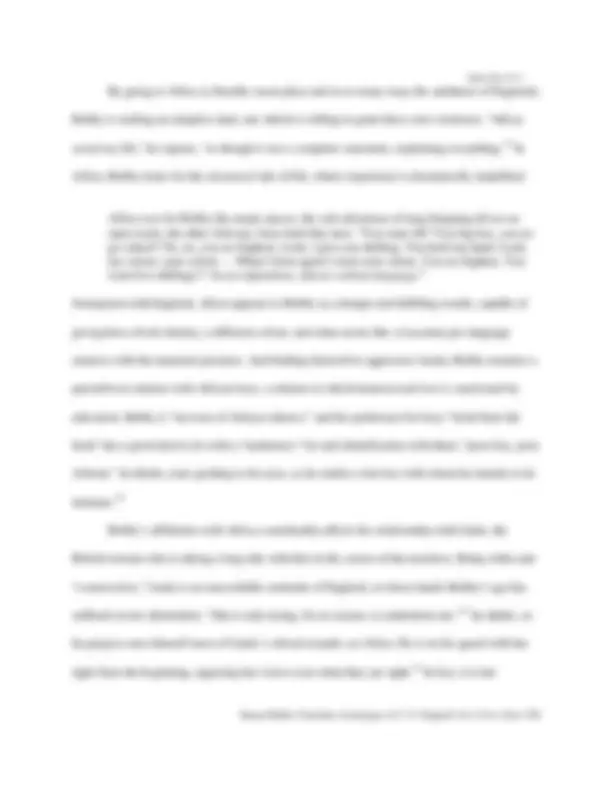
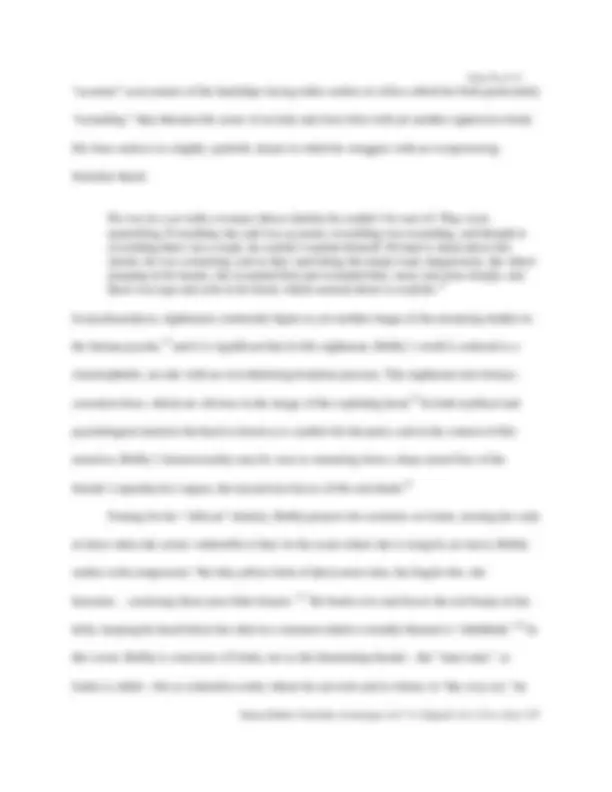
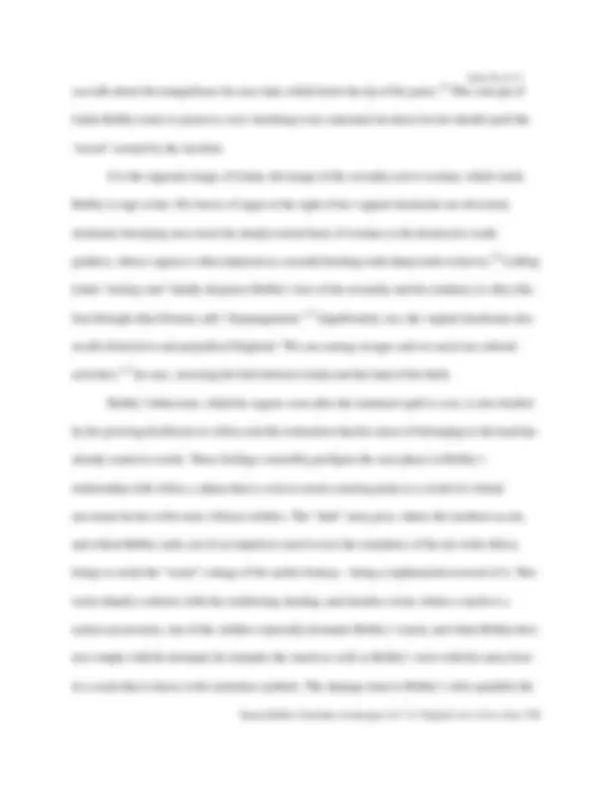
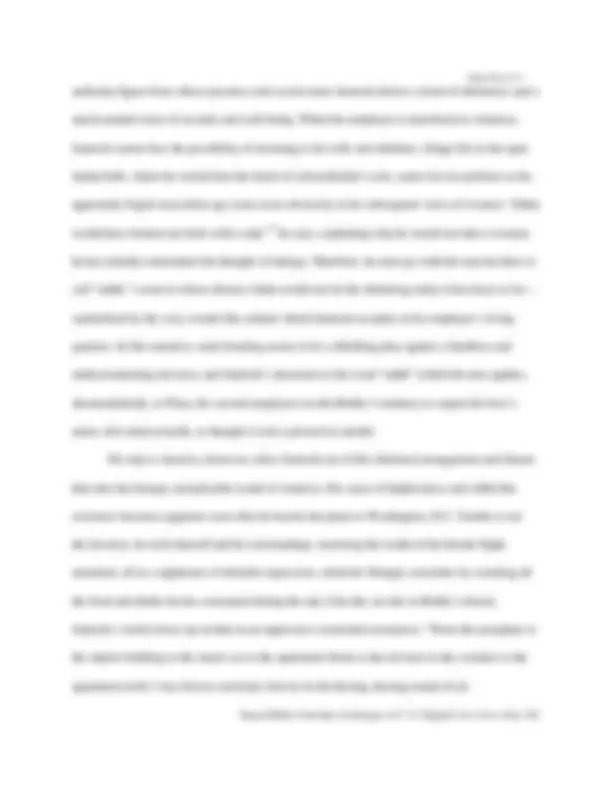
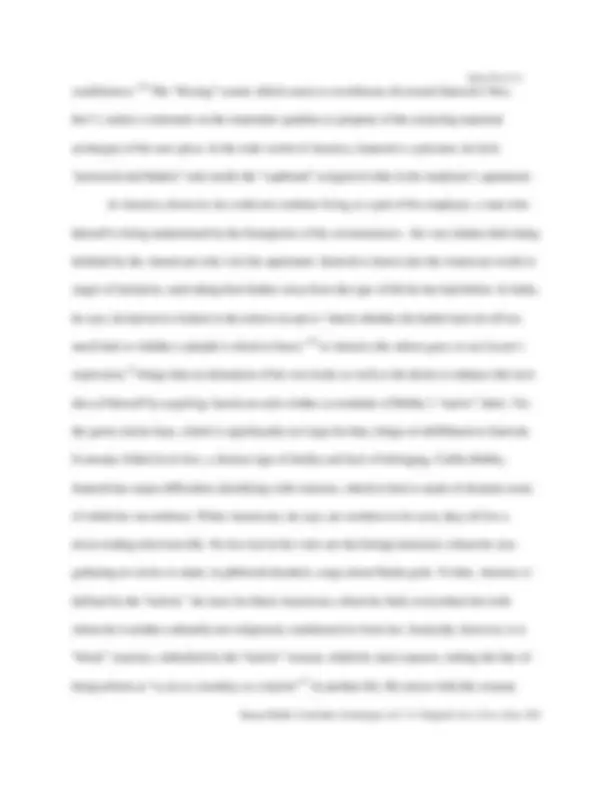
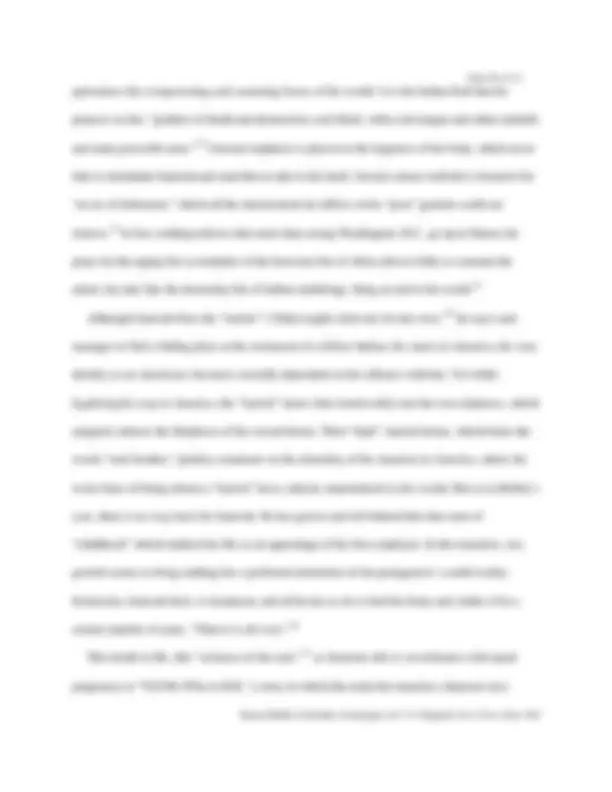
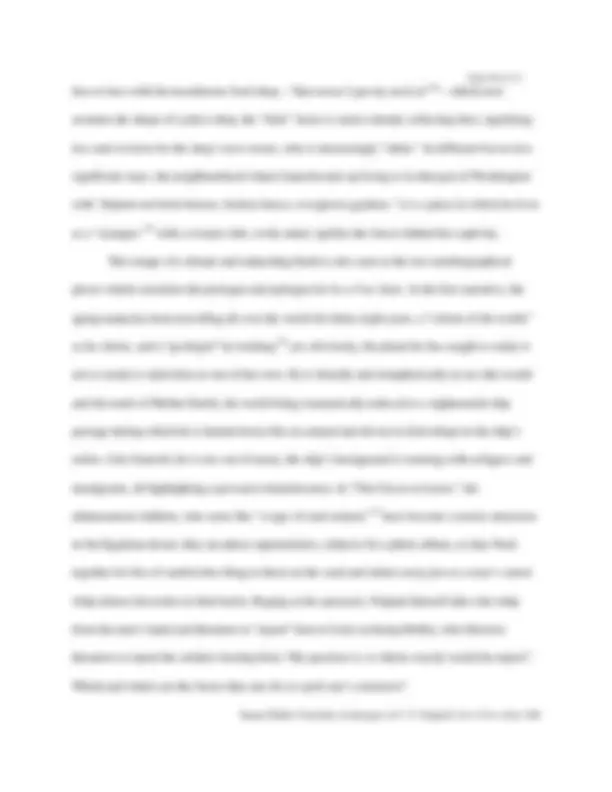
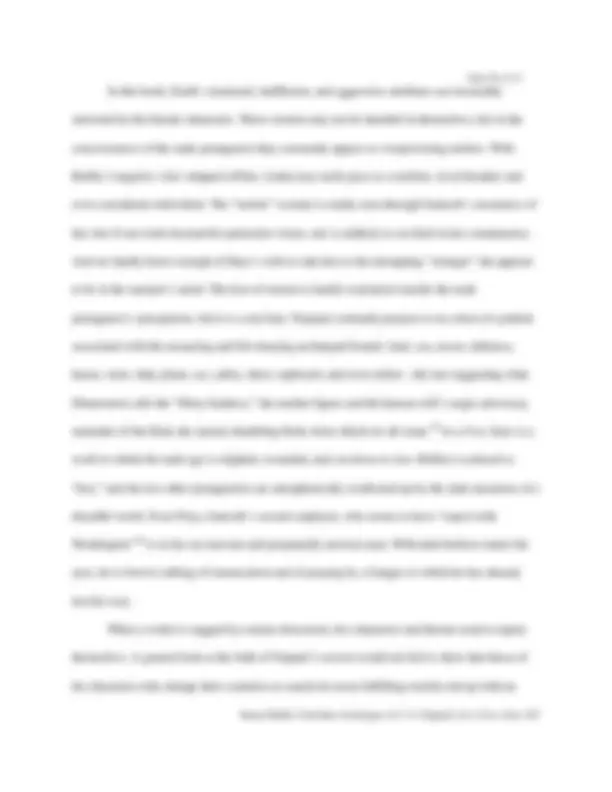
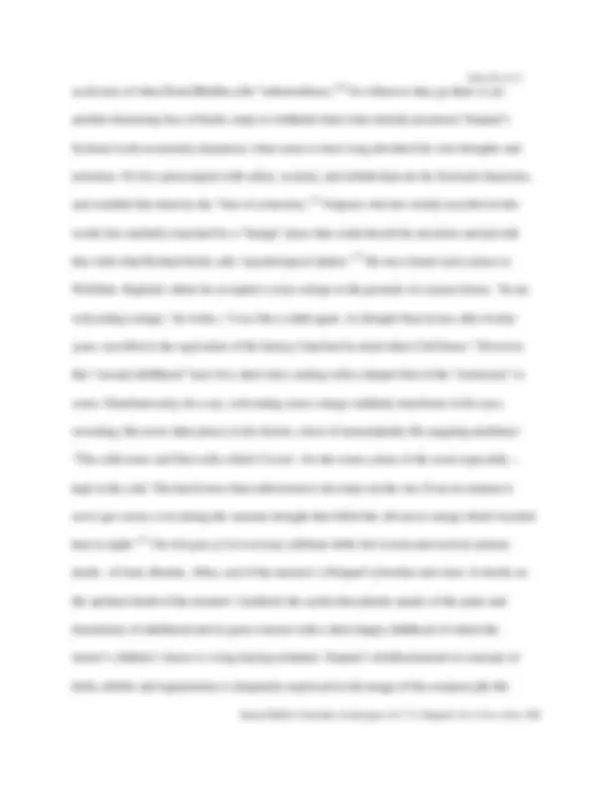


Study with the several resources on Docsity

Earn points by helping other students or get them with a premium plan


Prepare for your exams
Study with the several resources on Docsity

Earn points to download
Earn points by helping other students or get them with a premium plan
Community
Ask the community for help and clear up your study doubts
Discover the best universities in your country according to Docsity users
Free resources
Download our free guides on studying techniques, anxiety management strategies, and thesis advice from Docsity tutors
To start with “One out of Many,” the protagonist, Santosh, does not seem to be, like Bobby, socially stigmatised in his homeland; yet although he has had a.
Typology: Lecture notes
1 / 17

This page cannot be seen from the preview
Don't miss anything!










One of the central themes in the fictional pieces published under the title In a Free State^1 is the elusive nature of freedom. Each narrative contains one or more characters who run away from home only to discover that the “free state” they have run to is no less entrapping than the one they have escaped. The idea of the other home seems to reassure only to deceive, a discovery that Naipaul’s characters in this work, as well as elsewhere, seem to make while they resign themselves to their new “prisons.” This theme derives much of its force from Naipaul’s efforts to invest the land with the archetypal significance of Mother Earth, the force that gives life only to take it back, that nurtures only to destroy. Importantly, too, this particular view of the land is invariably linked to the image of woman in the narratives; land and woman often emerge as metamorphic entities whose roles are pieced together in an extended pattern of parallelism, especially in the consciousness of the male protagonists. Woman appears as the land’s representative or “proxy,” to use Paglia’s term which identifies women with nature. This intricately woven design of archetypes clearly reflects the complexity of Naipaul’s vision of
feminine force and accounts for the narratives’ distinct feminine presence.^2 The events of the title narrative (which, by virtue of its length, will receive more attention than the others) chiefly unfold in an African state, but flashbacks on the British Bobby’s past serve to reveal some important details about his life in England, all imbued with archetypal tones. Of Bobby’s childhood only one incident stands out: he was bitten by his mother’s (not his parents’) dog and he still carries the wound of this bite, a deep scar on his calf and an irrational fear of dogs. In mythical and archetypal accounts, the dog is the “principal animal” of some distinctly negative, blood-shedding goddesses, such as Gorgon and Hecate, who are widely viewed by psychoanalysts as manifestations of the life-denying mother figure in the human psyche.^3 Significantly, too, fear and pain, which define Bobby’s childhood, also throw a long shadow on his adult life. As a young man, Bobby is a displaced and fragmented individual who undergoes a major nervous breakdown for eighteen months. A breakdown of this kind, which is defined by Bobby as “death,”^4 has been frequently interpreted by psychoanalysts as the human psyche’s experience of being swallowed up by the Terrible Mother.^5 This image of the mother figure as a formidable adversary is transmitted to the land—to Mother England first, which assumes the dimensions of a dark prison cell for her repressive traditional expectations (Bobby, in fact, is literally jailed for homosexual practices). His yearning for a second birth, away from the shackles of England, finds a clear expression in his fantasy quest of driving endless miles through a cold and rainy night in an effort to reach a womb-like cottage on top of a hill: “There would be a fire there, and it would be warm and I would be perfectly safe.”^6 Notably, too, this cottage is a timeless place where Bobby steps on his watch and refuses to mend it, fulfilling thus a desire “to give up, to be nothing, to do nothing.”^7
“accurate” assessments of the hardships facing white settlers in Africa which he finds particularly “wounding:” they threaten his sense of security and leave him with yet another oppressive bond. His fears surface in a highly symbolic dream in which he struggles with an overpowering feminine threat:
He was in a car with a woman whose identity he couldn’t be sure of. They were quarrelling. Everything she said was accurate; everything was wounding, and though to everything there was a reply, he couldn’t explain himself. He had to shout above her shouts; he was screaming; and as they sped along the empty road, dangerously, the wheel jumping in his hands, she wounded him and wounded him, more and more deeply; and there was rage and ache in his head, which seemed about to explode.^13 In psychoanalysis, nightmares commonly figure as yet another image of the ensnaring mother in the human psyche,^14 and it is significant that in this nightmare, Bobby’s world is reduced to a claustrophobic car ride with an overwhelming feminine persona. This nightmare also betrays castration fears, which are obvious in the image of the exploding head.^15 In both mythical and psychological analysis the head is known as a symbol for the penis, and in the context of this narrative, Bobby’s homosexuality may be seen as stemming from a deep-seated fear of the female’s reproductive organs, the mysterious forces of life and death.^16 Fearing for his “African” identity, Bobby projects his anxieties on Linda, trusting her only at times when she seems vulnerable to him. In the scene where she is stung by an insect, Bobby studies with compassion “the thin yellow folds of [her] moist skin, the fragile ribs, the brassiere… enclosing those poor little breasts.”^17 He bends over and kisses the red bump on her belly, keeping his head below her shirt in a moment which is notably likened to “childbirth.”^18 In this scene, Bobby is conscious of Linda, not as the threatening female—the “man-eater,” as Linda is called—but as a harmless entity whom he can trust and to whom, in “the cosy car,” he
can talk about the tranquilizers he once had, which burnt the tip of his penis.^19 This concept of Linda Bobby wants to preserve, now watching every statement he utters lest he should spoil the “mood” created by the incident. It is the opposite image of Linda, the image of the sexually active woman, which sends Bobby to rage at her. His bursts of anger at the sight of her vaginal deodorant are obviously irrational, betraying once more his deeply rooted fears of woman as the destructive tooth goddess, whose vagina is often depicted as a mouth bristling with sharp teeth or knives.^20 Calling Linda “rotting cunt” hardly disguises Bobby’s fear of her sexuality and his tendency to allay this fear through what Horney calls “disparagement.”^21 Significantly, too, the vaginal deodorant also recalls dismissive and prejudiced England: “We are among savages and we need our cultural activities,”^22 he says, stressing the link between Linda and the land of his birth. Bobby’s behaviour, which he regrets soon after the irrational spell is over, is also fuelled by his growing disillusion in Africa and the realisation that his sense of belonging to the land has already started to erode. These feelings ostensibly prefigure the next phase in Bobby’s relationship with Africa, a phase that is soon to reach a turning point as a result of a brutal encounter he has with some African soldiers. The “dark” army post, where the incident occurs, and which Bobby seeks out of an impulsive need to test the soundness of his ties with Africa, brings to mind the “warm” cottage of his earlier fantasy—being a nightmarish reversal of it. This room sharply contrasts with the comforting, healing, and timeless room, where a watch is a useless possession; one of the soldiers especially demands Bobby’s watch, and when Bobby does not comply with his demand, he tramples the watch as well as Bobby’s wrist with his army boot in a scene that is heavy with castration symbols. The damage done to Bobby’s wrist parallels the
in the air, millions and millions of white butterflies, fluttering out of the forest. And the storm did not stop.”^25 The expulsion of the white butterflies from the forest, the result of the burning out of the villages belonging to the king’s tribe (the king is said to be pro-British), also seems to make a comment on Africa’s tendency to alienate those whom she had nurtured in the past. In this narrative, birth, or rebirth, comes across as a paradoxical state of being, one which unfailingly prefigures the chains of experience. Bobby now has to live with the knowledge that Africa, too, no longer belongs to him, that his African identity is as flimsy as his shredded “native shirt,” which ironically is made in Holland. Back in his apartment, Bobby feels exposed, yet not unaware of the necessity to fend for himself. His servant’s indiscreet laughter at his bandages and humiliation makes him think of leaving Africa. But the compound where he lives is just as “good” as anywhere else. “I will have to sack Luke,”^26 he thinks. This way of reasoning is new to Bobby; it is so unlike his previous act of paying for the drinks of a Zulu male whore who has spat on his face in a public place. But the hardened Bobby knows very well that his carefree days are over. Naipaul’s concerns in the title novella resound with no less intensity in the other narratives of this book, especially the fictional ones, in which the archetypal theme is outlined in briefer yet equally undisguised notes. To start with “One out of Many,” the protagonist, Santosh, does not seem to be, like Bobby, socially stigmatised in his homeland; yet although he has had a wife and has fathered some children, Santosh has obviously been quite content with the physical and psychological distance that separates him from married life. As he states, he could not imagine living with his wife and children “for good;” he finds instead a safer haven in his bachelor lifestyle in Bombay, where he works as a cook for a government agent—a male
authority figure from whose presence and social status Santosh derives a kind of wholeness and a much-needed sense of security and well-being. When his employer is transferred to America, Santosh cannot face the possibility of returning to his wife and children; village life in the open Indian hills, where he would bear the brunt of a householder’s role, seems far too perilous to his apparently fragile masculine ego (seen more obviously in his subsequent views of women: “[She] would have broken my back with a slap”^27 he says, explaining why he would not date a woman he has initially entertained the thought of dating). Therefore, he must go with the man he likes to call “sahib,” a man in whose absence India would not be the sheltering entity it has been so far— symbolised by the cosy, womb-like cabinet which Santosh occupies in his employer’s living quarters. In this narrative, male bonding seems to be a shielding ploy against a heedless and undiscriminating universe, and Santosh’s attraction to the word “sahib” (which he also applies, absentmindedly, to Priya, his second employer) recalls Bobby’s tendency to repeat his boss’s name, also unnecessarily, as though it were a protective amulet. His trip to America, however, takes Santosh out of this sheltered arrangement and thrusts him into the foreign, inexplicable world of America. His sense of helplessness and child-like existence becomes apparent soon after he boards the plane to Washington, D.C. Unable to use the lavatory, he soils himself and his surroundings, incurring the wrath of the female flight attendant, all in a nightmare of infantile regression, which he fittingly concludes by vomiting all the food and drinks he has consumed during the trip. Like the car ride in Bobby’s dream, Santosh’s world closes up on him in an oppressive existential awareness: “From the aeroplane to the airport building to the motor car to the apartment block to the elevator to the corridor to the apartment itself, I was forever enclosed, forever in the hissing, hissing sound of air
epitomises the overpowering and castrating forces of his world: it is the Indian Kali that he projects on her, “goddess of death and destruction, coal-black, with a red tongue and white eyeballs and many powerful arms.”^32 Unusual emphasis is placed on the largeness of her body, which never fails to intimidate Santosh and send him to take to his heels. Sexual contact with her is bound to be “an act of dishonour,” which all the chastisement he inflicts on his “poor” genitals could not remove.^33 In fact, nothing relieves him more than seeing Washington, D.C., go up in flames; he prays for the raging fire (a reminder of the ferocious fire of Africa above) fully to consume the entire city and, like the doomsday fire of Indian mythology, bring an end to his world.^34 Although Santosh flees the “ hubshi ” (“[She] might claim me for her own,”^35 he says) and manages to find a hiding place at the restaurant of a fellow Indian, his status in America, his very identity as an American, becomes crucially dependent on his alliance with her. Yet while legalising his stay in America, the “ hubshi ” draws him irretrievably into her own darkness, which uniquely mirrors the bleakness of his second home. Their “dark” marital house, which bears the words “soul brother,” plainly comments on the absurdity of his situation in America, where his worst fears of being reborn a “ hubshi ” have, indeed, materialised in this world. But as in Bobby’s case, there is no way back for Santosh. He has grown and left behind him that state of “childhood” which marked his life as an appendage of his first employer. In this narrative, too, growth seems to bring nothing but a profound intimation of the protagonist’s sordid reality. Extinction, Santosh feels, is imminent, and all he has to do is feed his body and clothe it for a certain number of years. “Then it is all over.”^36 This death in life, this “sickness of the soul,”^37 as Santosh calls it, reverberates with equal poignancy in “Tell Me Who to Kill,” a story in which the main but nameless character also
follows the ancient lure of a foreign land, his motherland having faltered in her mission of nurturing him as well as his brother/lover/alter ego. The deprivations of his formative years find a clear expression in his conspicuous yearning for a solid and ego-endorsing house (a typical yearning in Naipaul’s protagonists); however, the houses he craves for himself all seem to change their hue and, startlingly, to close in on their occupants: for instance, his uncle Stephen’s house after the failure of his son in Canada, or that of the rich neighbour in which the man mysteriously dies—this “big” house, which he once lends for a wedding, turns out to be not only small on the inside, but dimly lit, smelling of dead rats and thoroughly infested with woodlice. In London, the narrator aims to “mother” the “poor” and “beautiful” boy, Dayo, working two jobs to combat the poverty of his background. But the London which offers cash with one hand soon grabs it with the other, tellingly assuming the contour of a tempting curry-and-roti shop. Instead of giving sustenance, the “food” shop drains his energy, leaving him “like a Samson without his hair,”^38 cut down to size by a perfidious feminine archetype. “Tell Me Who to Kill,” the titles goes, but it is the narrator’s body, as well as his own brother’s, which finally occupies the “chest” in the story’s hallucinated murder scene.^39 London’s alienating impulses are aptly defined by the mental institution where he is a “dead man” to the world, placed under the guardianship of Frank, a seemingly maladjusted homosexual, who vindicates himself by continuously probing the drawbacks of the British social system. “He is forever worrying me with his discrimination enquiries,” the narrator says, “digging me all the time because he prefer to see me weak. He like opening up manholes for me to fall in; he is anxious to push me down in the darkness.”^40 Instinctively, the narrator seems to know that the darkness which has sucked him in cannot be explained by Frank’s anxious rationalisations.
face to face with the treacherous food shop—“that noose I put my neck in”^44 —which now assumes the shape of a jokes-shop, the “false” items it carries already collecting dust, signifying loss and eviction for the shop’s new owner, who is interestingly “white.” In different but no less significant ways, the neighbourhood where Santosh ends up living is in that part of Washington with “[b]urnt-out brick houses, broken fences, overgrown gardens;” it is a place in which he lives as a “stranger,”^45 with a woman who, in his mind, typifies the forces behind his captivity. This image of a distant and unheeding Earth is also seen in the two autobiographical pieces which constitute the prologue and epilogue for In a Free State. In the first narrative, the aging tramp has been travelling all over the world for thirty-eight years, a “citizen of the world,” as he claims, and a “geologist” by training;^46 yet, obviously, the planet he has sought to study is not so ready to claim him as one of her own. He is literally and metaphorically at sea (the womb and the tomb of Mother Earth), his world being traumatically reduced to a nightmarish ship passage during which he is hunted down like an animal and driven to find refuge in the ship’s toilets. Like Santosh, he is one out of many; the ship’s background is teeming with refugees and immigrants, all highlighting a pervasive homelessness. In “The Circus at Luxor,” the dehumanised children, who seem like “a type of sand animal,”^47 have become a tourist attraction in the Egyptian desert; they are photo opportunities, subjects for a photo album, as they flock together for bits of sandwiches flung to them on the sand and skitter away just as a man’s camel whip almost descends on their backs. Raging at the spectacle, Naipaul himself takes the whip from the man’s hand and threatens to “report” him to Cairo (echoing Bobby, who likewise threatens to report the soldiers beating him). The question is, to whom exactly would he report? Which and where are the forces that care for or spoil one’s existence?
In this book, Earth’s irrational, indifferent, and aggressive attributes are invariably mirrored by the female characters. These women may not be harmful in themselves, but in the consciousness of the male protagonist they constantly appear as overpowering entities. With Bobby’s negative view stripped off her, Linda may easily pass as a realistic, level-headed, and even considerate individual. The “ hubshi ” woman is totally seen through Santosh’s awareness of her, but if one looks beyond his particular vision, one is unlikely to see Kali in her countenance. And we hardly know enough of Dayo’s wife to take her as the entrapping “stranger” she appears to be in the narrator’s mind. The fear of women is hardly warranted outside the male protagonist’s perceptions, but it is a real fear. Naipaul constantly projects it on a host of symbols associated with the ensnaring and life-denying archetypal female: land, sea, moon, darkness, house, store, ship, plane, car, cabin, chest, cupboard, and even toilets—the last suggesting what Dinnerstein calls the “Dirty Goddess,” the mother figure and the human will’s major adversary, reminder of the flesh, the mortal, humbling flesh, from which we all come.^48 In a Free State is a work in which the male ego is slighted, wounded, and cut down to size. Bobby is reduced to “boy,” and the two other protagonists are metaphorically swallowed up by the dark mysteries of a dreadful world. Even Priya, Santosh’s second employer, who seems to have “coped with Washington”^49 is in fact an insecure and perpetually anxious man. With dark hollows under his eyes, he is forever talking of renunciation and of praying by a Ganges to which he has already lost his way. When a writer is nagged by certain obsessions, his characters and themes tend to repeat themselves. A general look at the bulk of Naipaul’s oeuvre would not fail to show that those of his characters who change their countries in search for more fulfilling worlds end up with an
gardener Pitton has established behind the children’s house as a “grass-and-leaf-and-flower graveyard.”^54 It is an image that clearly speaks of the dreadful cycle of life and death, of the morbid fear of a world “in flux,” a world in which things are created only to die—“Grass to hay to earth.”^55
(^12) V. S. Naipaul, In a Free State (Harmondsworth: Penguin, 1973). for instance, Consuelo Lopez de Villegas, “Matriarchs and man-eaters: Naipaul’s Fictional Women” (Naipaul’s portrayal of women has been criticised as rough and distasteful, the result of misogyny on his part. See, Revista Interamericana Deborah Lucas Schneider, eds., 7.4, 1977-78), 605-15; Martha Lewis, “Bitches and Householders” in Fritz Fleischmann and Women Studies and Literature (Erlangen: Palm and Inke, 1985), 179-212; Helen Pyne-Timothy, “Women and Sexuality in the Later Novels of V. S. Naipaul” (Elaine Fido, “Psycho-Sexual Aspects of the Woman in V. S. Naipaul’s Fiction” in Mark McWatt, ed., WLWE 25.2, 1985), 298-306; and West Indian Literature and Its Social Context harshness towards women often derives from a deep-rooted fear of the female archetype, which Naipaul’s male (Barbados: University of the West Indies, 1985), 78-118. In my view, this characters invariably project onto the women they associate with. For more details on this subject, see my archetypalanalysis of Mr Stone and the Knights Companion : Sanna Dhahir, “Mistress of the Tomb, I Fear You: Feminine Archetypes in V.S. Naipaul’s (^3) Erich Neumann, The Great Mother: An Analysis of the Archetype Mr Stone and the Knights Companion , trans. Ralph Manheim (New York: Pantheon,” ( Commonwealth 24.2, 2002), 93-105. 1963), 170. (^4) Naipaul, In a Free State, 116. (^5) Neuman, 27; Judith Fryer, The Faces of Eve: Women in the Nineteenth-Century Novel (New York: Oxford University Press, 1976), 189. (^6) Naipaul, In a Free State, 153. (^78) Ibid. 9 Ibid., 116.Ibid., 109; emphasis added. (^1011) Ibid., 105, 190. 12 Ibid., 143.According to Landeg White, “Bobby never disagrees with Linda without being proved wrong.” See Landeg White, V. S. Naipaul: A Critical Introduction (^13) Naipaul, In a Free State, 197. (London: Macmillan, 1975), 198. (^14) See C. G. Jung, Aspects of the Feminine , trans. R. F. C. Hull (London: Ark Paperbacks, 1982), 110; Neumann, 149; Wendy Doniger O’Flaherty,Press, 1980), 203. Women, Androgens, and Other Mythical Beasts (Chicago: University of Chicago (^15) While working on In a Free State , Naipaul himself had been troubled for “a year or more” by a recurring nightmare in which he is thrown flat on his back by a sudden “explosion” in his head. He later describes this book as“an attempt to find a story for, to give coherence to” this “unsettling” dream. The “fear” and “uncertainty” which Naipaul experienced during this period, and which drove him to seek a period of pastoral calm in a Wiltshirecottage, were transferred, he says, to Africa. See V. S. Naipaul, The Enigma of Arrival (New York: Alfred Knopf, 1987), 99-100. (^16) Horney argues that “Male homosexuality has for its basis... the desire to escape from the female genital, or to deny its very existence:” Karen Horney, “The Dread of Women” ( International Journal of Psychoanalysis 13, 1932,
348-60), 351. See also Paglia’s comments on the same subject: Camille Paglia, from Nefertiti to Emily Dickinson (New York: Vintage Books, 1991), 15. Sexual Personae: Art and Decadence (^1718) Naipaul, In a Free State, 151. 19 Ibid., 152.Ibid. (^20) Neumann documents the recurrence in world mythology of the tooth goddess or the Vagina Dentata, whose womb devours what it has created. See also O’Flaherty for further comments on this aspect of the negative sexual mother. (^21) Naipaul, In a Free State, 351. (^2223) Ibid., 219. 24 Ibid., 233.Ibid., 234. (^2526) Ibid., 234-35. 27 Ibid., 238.Ibid., 51. (^2829) Ibid., 26-7. 30 Ibid., 35.Jacques Lacan, The Seminar of Jacques Lacan , ed. Jacque-Alain Miller, trans. John Forrester, vol.1 (New York: Norton), 1988. (^31) Ibid. (^3233) Ibid., 38. 34 Ibid.While fire is a notable image of the archetypal female in world mythology, it is chiefly connected in Hindu myths with the insatiable, life-annihilating mother. For insightful comments on the “doomsday fire,” which, according tosome myths, will eventually dry up the ocean and destroy the world, see O’Flaherty, 213-37. (^3536) Naipaul, In a Free State, 46-7. 37 Ibid., 38.Ibid., 47. (^3839) Ibid., 88. 40 Ibid., 97.Ibid., 86. (^4142) Ibid., 96. 43 Ibid., 100.Ibid., 59. (^4445) Ibid., 95. 46 Ibid., 57.Ibid., 9. (^4748) Ibid., 241. Harper and Row, 1976).Dorothy Dinnerstein,^ The Mermaid and the Minotaur: Sexual Arrangements and Human Malaise^ (New York: (^4950) Ibid., 45. 51 Homi Bhabha,Naipaul, Enigma,^ The Location of Culture 52.^ (London: Routledge, 1994). (^5253) Richard Kelly, V. S. Naipaul (New York: Continuum, 1989). 54 Ibid., 88.Ibid., 201. (^55) Ibid., 87.